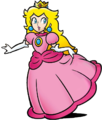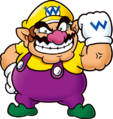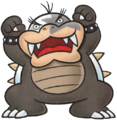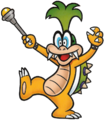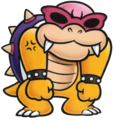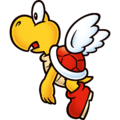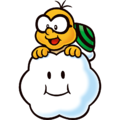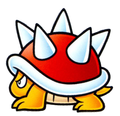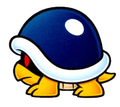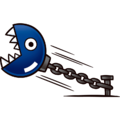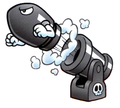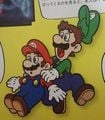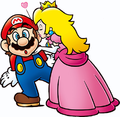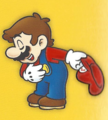Super Mario Bros. Encyclopedia
- Not to be confused with Perfect Edition of the Great Mario Character Encyclopedia.
Super Mario Bros. Encyclopedia (full title: Super Mario Encyclopedia: The Official Guide to the First 30 Years), also known as [Nintendo Official Guide Book] Super Mario Bros. Encyclopedia 30th Anniversary 1985-2015[1] and as Super Mario Bros. Encyclopedia: Nintendo Official Guide Book (Japanese: スーパーマリオブラザーズ百科: 任天堂公式ガイドブック Sūpā Mario Burazāzu Hyakka: Nintendō Kōshiki Gaido Bukku) in Japan, is an encyclopedia that was released exclusively in Japan on October 19, 2015, as part of the celebration of the 30th anniversary of Super Mario Bros.. The book covers characters, enemies, power-ups, items, stages, techniques and graphics from all 17 titles in the main Super Mario series up to Super Mario 3D World,[2] as well as developer interviews, concept art, well-known glitches, and level design explanations.[3] It contains 256 pages.
This book was supposed to be translated in English and released in North America and Europe by Dark Horse Comics on June 15, 2017,[4] although preorders for the English translation were canceled in May 2017,[5] and the release date had been moved to October 23, 2018.[6] However, the date was later modified again, this time on October 16.[7] Its German translation was released on October 12, 2017 by Tokyopop,[8] its Spanish translation was released on the October 17 by Planeta Cómic,[9] its French translation was published on July 4, 2018 by Soleil Productions in the Soleil Manga collection,[10][11] and the Italian translation was published on November 15th, 2018 by Magazzini Salani.[12][13]
Controversy
Following the release of the encyclopedia in English, it was found that one of the translators, Zack Davisson, had taken conjectural and foreign names for characters from fan websites such as the Super Mario Wiki and Mario Wikia.[14] This especially concerns enemies and characters from Super Mario Land 2: 6 Golden Coins, as well as others such as Winged Strollin' Stu (dubbed by the book by its former conjectural name used on the Super Mario Wiki, "Soarin' Stu"), and Lumacomète, which is actually the character's French name, used by the Super Mario Wiki, due to a lack of an English name.[15]
List of English translation errors and typos not from the Super Mario Wiki
This article is under construction. Therefore, please excuse its informal appearance while it is being worked on. We hope to have it completed as soon as possible.
The English translation erroneously states that the first unmodified American release of Super Mario Bros.: The Lost Levels was the Wii U Virtual Console release in 2014, despite that title actually going to the earlier Wii Virtual Console release in 2007.
The English translation also states that the POW Block debuted in Super Mario Bros., which is not true as it debuted in Mario Bros., with its Super Mario series debut being Super Mario Bros. 2.
On pages 71 and 86, the English translation misspells Wiggler as "Wriggler."
On page 149, the description for W9-3 states: "On this course, Banzai Bills and Bull's-Eye Banzais come one after the other." It should mention Bull's-Eye Bills (or Missile Bills), not Banzai Bills.
In the Super Mario 3D World section the screenshot for the ? Box actually depicts a Propeller Box. Also, the icon shown for Captain Toad Makes a Splash is the one for a Mystery House instead of that of a Captain Toad course.
On page 226, in the Super Mario 3D World section, Fizzlit is erroneously spelt as Fizzlet.
On the Super Mario 64 section, the Wiggler is treated as the generic enemy rather than an individual, using plural tense, and stating that they are angry when Mario stomps them. In actuality, it is a boss found at the Tiny-Huge Island.
On page 245, under DENSETSU NO STAFY 3, it is stated that "Mario appears during a stage." In actuality, this is Wario, which is mentioned correctly in the Japanese version.
On page 236, the first Warp Zone in Super Mario 3D World is erroneously stated to be found in Conkdor Canyon (World 2-1), when in reality it is found in Koopa Troopa Cave (World 1-2).
List of English translation mistakes and names from the Super Mario Wiki
- Page 44: Genkotsu is known as "Pipe Fist", which was a conjectural title from 2015 to 2018.
- Page 55: Tornado is known as "Tweester" in the Super Mario Bros. 3 section, which was conflated by the wiki from 2006 to 2017. The same oddity exists in Prima Games' Playing with Power: Nintendo NES Classics.
- Page 63: Fire P-Pakkun is known as "Fire Jumpin’ Piranha", which is based on the conjectural "Fire Jumping Piranha" title from 2015 to 2018.
- Pages 75 and 76: With the exception of "Fireball Boy" (F Boy), nearly every enemy name from Super Mario Land 2: 6 Golden Coins is directly lifted from the wiki titles, with macrons removed from Japanese names where applicable. This includes "Be" and "Bomubomu", which went under the names B Fly and Bomubomu 1 2 3 in the Japanese version. A similar action was also done to the unlocalized enemies from Zelda II: The Adventure of Link in Dark Horse's The Legend of Zelda: Arts & Artifacts. Additionally, "Ant" was a misattributed term, and "Bibi" had a name in Nintendo Power, leading both articles to be retitled in 2019.
- Page 78: The Moneybag item is known as "Money Bag", which was an unsourced title from 2007 to 2017.
- Page 85: In the Super Mario 64 section, the "Boss Bass" entry states that it is also known as "Bubba" in the description, which is not mentioned in the Japanese version. With current information, it is Cheep Chomp that is considered to have had the alternate name Bubba, with Boss Bass being a separate but similar enemy.
- Page 86: The Moneybags enemy is known as "Moneybag" in the Super Mario 64 section only. This was the same mistake on the wiki from 2009 to 2018.
- Page 92: Chair is known as "Killer Chair", which is a translation of an unsourced Japanese name styled after Killer Book and Killer Piano. In the book, the latter two are listed among enemies, while the former is listed among items & obstacles. Additionally, it has a completely different name in the Japanese version of the book (Poltergeist).
- Page 92: Keronpa Ball is known as "Kuromame", which is a romanization of its original Japanese name used as the wiki title from 2011 to 2017. The Japanese version of the book uses the name Keronpa Ball, which is based on the enemy's appearance as Keronpa in Super Mario 64 DS.
- Page 99: Huge Red Electrokoopa is known as "Electro-Koopa (green)", which was a conjectural title from 2015 to 2019.
- Page 99: Swoopin' Stu is known as "Gooble", which is an unconfirmed name used by the wiki from 2015 to 2019.
- Page 100: Winged Strollin' Stu is known as "Soarin’ Stu", which was a conjectural title from 2007 to 2017.
- Page 101: The captain is known as "Pianta Captain", which was a conjectural title from 2007 to 2019.
- Page 101: The Noki grandson is known as "Noki Elder's Grandson", which was a conjectural title from 2010 to 2019.
- Page 105: The electric goop is known as "Electric Graffiti", the Orange Juice Generator is known as "Forcefield", and the burning goop is known as "Lava Graffiti", respectively, which were conjectural names in the graffiti article from roughly 2008 to 2019.
- Pages 113 and 117: Kyodai Hanachan is known as "Big Wiggler", which was conflated by the wiki since 2013 until a 2019 proposal.
- Page 119: The face block is known as "Platform Block", which was an unsourced title from 2009 to 2019.
- Page 119: Blue Coin is known as "Silver Coin" in the New Super Mario Bros. section, which was the case in the Silver Coin article until a 2018 proposal.
- Page 126: Comet Tico is known as "Lumacomète", which was a French name used as the article title from 2012 to 2018 that was briefly changed in 2014 and 2015.
- Page 127: Spoing is known as "Bouncing Scuttlebug" in the Super Mario Galaxy section only. This is a remnant of when Spoing and Sprangler were erroneously considered Scuttlebugs by the wiki, which was settled via a 2012 proposal that was mistakenly neglected until 2018.
- Page 127: Skeletal Fish Guard is known as "Fish Bone". The wiki considered them the same thing despite different appearances and Japanese names until a 2018 proposal.
- Page 128: Bat is known as "Swoop" in the Super Mario Galaxy section only. The wiki considered them the same thing despite different appearances and Japanese names (but with basis within internal data) from 2007 to 2017.
- Pages 127 and 159: Mini Wanwan is known as "Chibi Chomp". This is a localization of its alternate Japanese name (Chibi Wanwan) that was used as the wiki title from 2016 to 2017.
- Pages 127 and 159: Fire Pressure is known as "Fire Shooter", which was a conjectural title from 2007 to 2015.
- Pages 128 and 160: Stink Bug Parent is known as "Mandibug Stack", which was a conjectural title from 2013 to 2017.
- Pages 128 and 160: Micro Mecha-Bowser is known as "Mechakoopa" in the Super Mario Galaxy section and "Mini Mechakoopa" in the Super Mario Galaxy 2 section. The wiki considered them the same thing despite different appearances and Japanese names until a 2018 proposal.
- Pages 128 and 161: Petapeta is known as "Starbag", which is the wiki's fan-translation of its apparent German name used as the article title from 2009 to 2017.
- Pages 128 and 161: Jump Beamer is known as "Sentry Beam", with the actual Sentry Beam known by its Japanese name "Laser Pod" in the Super Mario Galaxy section and the name "Mobile Sentry Beam" (on page 160) in the Super Mario Galaxy 2 section. Additionally, Ball Beamer is known as "Bolt Beam" (on page 126) and its description suggests that it is a derivative of the book's Sentry Beam, which is not mentioned in the Japanese version. This is all based on previous versions of the Sentry Beam article from 2010 to 2018, where the conjectural names "Mobile Sentry Beam" and "Bolt Sentry Beam" also appear initially.
- Pages 128 and 161: The names of Spiny Piranha Plant and its sequel derivative, Prickly Piranha Plant, are swapped. This mirrors a mistake on the wiki that went unnoticed from 2010 to 2019, when the Piranha Plant guidance from Super Smash Bros. Ultimate Ver. 2.0.0 used the correct names.
- Page 136: Banandelion is known as "Fling Flower", which was a separate article using a conjectural title from 2011 to 2018.
- Pages 137 and 171: Rubbery bulb is known as "Stretch Plant", which was a conjectural title from 2010 to 2019.
- Pages 144 and 146: Hefty Goomba and Big Goomba are respectively known as "Big Goomba" and "Mega Goomba" in the New Super Mario Bros. Wii section only. This is taken from the original wiki articles, which were not fixed until 2018.
- Page 150: Obake Stand is known as "Ghost Vase", which was a conjectural title from 2010 to 2017.
- Pages 151 and 217: The ash is known as "Volcanic Smoke", which was a conjectural title from 2016 to 2018.
- Page 159: Fiery Gobblegut is known as "Fire Gobblegut", which was a conjectural title from 2010 to 2016.
- Page 160: Golden Gummit is known as "Gold Gummit", which was a conjectural name in the Gummit article from 2013 to 2019.
- Page 161: Tongari is known as "Spiny Hermit", which was a conjectural title from 2010 to 2019.
- Page 161: Bee Eater is known as "Spiny Stretch Plant", which was a conjectural name in the Stretch Plant article from 2010 to 2019.
- Page 161: Flower Mimic is known as "Venus Flower Trap", which was a conjectural title from 2011 to 2019.
- Page 161: Pattan is known as "Whimp", which was a conjectural title from 2010 to 2018 that was briefly changed in 2015.
- Page 210: Dai Gorō is known as "Mega Grrrol", which was a conjectural title from 2012 to 2017.
- Page 215: Huge Fire Bar is known as "Big Fire Bar", which was a conjectural title from 2015 to 2019.
- Page 217: Switchback is known as "Switchback Platform", which was a conjectural title from 2012 to 2018.
- Page 227: The pink Hisstocrat is known as "Queen Hisstocrat", which was a conjectural title from 2013 to 2019.
- Pages 137, 171 and 186: Note is known as "Rainbow Note", which was an unsourced title from 2006 to 2019.
Gallery
It has been requested that more images be uploaded for this section. Remove this notice only after the additional image(s) have been added.
A page covering enemies from Super Mario Bros.: The Lost Levels
- Bowser jr colouring book.png
Bullet Bill being fired from a Bill Blaster
- Mariobowtieshaded.png
Mario presenting with a bow tie
Trivia
- On page 64, Thwomps are described as "stone ghosts".
Names in other languages
| Language | Name | Meaning |
|---|---|---|
| Japanese | スーパーマリオブラザーズ百科: 任天堂公式ガイドブック Sūpā Mario Burazāzu Hyakka: Nintendō Kōshiki Gaido Bukku |
Super Mario Bros. Encyclopedia: Nintendo Official Guidebook |
| German | Super Mario Bros.-Enzyklopädie (working title)[16] Super Mario Encyclopedia - Die ersten 30 Jahre |
Super Mario Bros. Encyclopedia Super Mario Encyclopedia: The first 30 years |
| Italian | Super Mario Bros. Enciclopedia |
Super Mario Bros. Encyclopedia |
| Spanish (NOE) | Enciclopedia Super Mario Bros. |
Super Mario Bros. Encyclopedia |
References
- ^ Last page of the German translation of the Super Mario Bros. Encyclopedia..
- ^ (September 9, 2015). Nintendo releasing Super Mario encyclopedia in Japan. GoNintendo. Retrieved September 10, 2015.
- ^ Vogel, M. (October 21, 2015). Nintendo of Japan Has Just Published a 30th Anniversary Super Mario Bros. Complete Encyclopedia. Nintendo Life. Retrieved June 18, 2016.
- ^ Brian (February 18, 2017). Super Mario Bros. Encyclopedia coming to North America and Europe in June. Nintendo Everything. Retrieved August 29, 2017.
- ^ Brian (May 6, 2017). Amazon UK cancelling Super Mario Bros. Encyclopedia pre-orders. Nintendo Everything. Retrieved July 2, 2017.
- ^ ECCC 2018: Dark Horse Powers Up Publishing Line with "Super Mario Encyclopedia". Dark Horse. Retrieved February 20, 2018.
- ^ SUPER MARIO ENCYCLOPEDIA: THE OFFICIAL GUIDE TO THE FIRST 30 YEARS HC. Dark Horse. Retrieved May 2, 2018.
- ^ Page of the Super Mario Encyclopedia – Die ersten 30 Jahre on Tokyopop's online shop.
- ^ Page of the Enciclopedia Super Mario Bros 30ª Aniversario on PlanetadeLibros' site.
- ^ Official announcement of the release on Soleil Manga website.
- ^ https://www.amazon.fr/gp/product/2302070046
- ^ [1]
- ^ Twitter post about the release of the Italian translation of the Super Mario Bros. Encyclopedia from the official account of Salani.
- ^ [2]. October 25, 2018.
- ^ It Looks Like The Official Super Mario Encyclopedia Plagiarised A Fan-Made Wiki. Nintendo Life. Retrieved October 25, 2018.
- ^ Tokyopop April-June 2017 programme. Tokyopop. Retrieved July 3, 2018.












